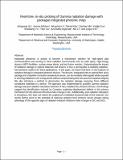Real-time, in situ probing of gamma radiation damage with packaged integrated photonic chips
Author(s)
Du, Qingyang; Michon, Jerome; Li, Bingzhao; Kita, Derek M.; Ma, Danhao; Zuo, Haijie; Yu, Shaoliang; Gu, Tian; Agarwal, Anuradha; Li, Mo; Hu, Juejun; ... Show more Show less
DownloadAccepted version (612.0Kb)
Open Access Policy
Open Access Policy
Creative Commons Attribution-Noncommercial-Share Alike
Terms of use
Metadata
Show full item recordAbstract
Integrated photonics is poised to become a mainstream solution for high-speed data communications and sensing in harsh radiation environments, such as outer space, high-energy physics facilities, nuclear power plants, and test fusion reactors. Understanding the impact of radiation damage in optical materials and devices is thus a prerequisite to building radiation-hard photonic systems for these applications. In this paper, we report real-time, in situ analysis of radiation damage in integrated photonic devices. The devices, integrated with an optical fiber array package and a baseline-correction temperature sensor, can be remotely interrogated while exposed to ionizing radiation over a long period without compromising their structural and optical integrity. We also introduce a method to deconvolve the radiation damage responses from different constituent materials in a device. The approach was implemented to quantify gamma radiation damage and post-radiation relaxation behavior of SiO2-cladded SiC photonic devices. Our findings suggest that densification induced by Compton scattering displacement defects is the primary mechanism for the observed index change in SiC. Additionally, post-radiation relaxation in amorphous SiC does not restore the original pre-irradiated structural state of the material. Our results further point to the potential of realizing radiation-hard photonic device designs taking advantage of the opposite signs of radiation-induced index changes in SiC and SiO2.
Date issued
2020-01Department
Massachusetts Institute of Technology. Department of Materials Science and Engineering; Massachusetts Institute of Technology. Materials Research LaboratoryJournal
Photonics Research
Publisher
Optical Society of America (OSA)
Citation
Du, Qingyang et al. "Real-time, in situ probing of gamma radiation damage with packaged integrated photonic chips." Photonics Research 8, 2 (January 2020): 186-193 © 2020 Chinese Laser Press
Version: Author's final manuscript
ISSN
2327-9125